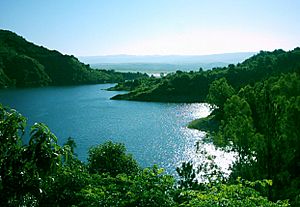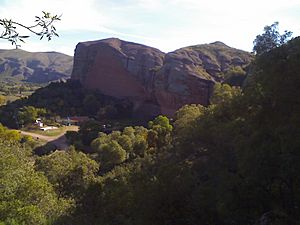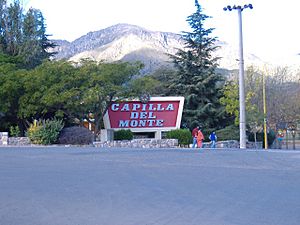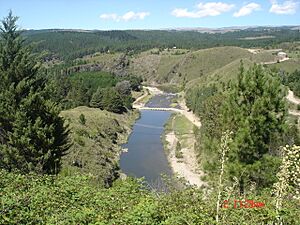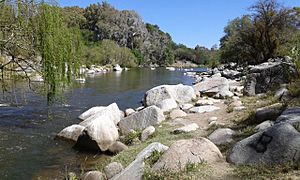Sierras de Córdoba facts for kids
Quick facts for kids Sierras de Córdoba |
|
|---|---|
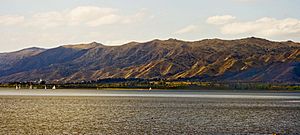
Sierras de Córdoba
|
|
| Highest point | |
| Peak | (Mount Champaquí) |
| Elevation | 2,880 m (9,450 ft) |
| Dimensions | |
| Length | 430 km (270 mi) |
| Geography | |
| Country | Argentina |
| Provinces | Córdoba and San Luis |
The Sierras de Córdoba are a group of mountains in central Argentina. They sit between the flat Pampas lands to the east and south, and the Chaco region to the north and east. Most of these mountains are in Córdoba Province. A small part of them is also in San Luis Province.
These mountains are part of a larger system called the Sierras Pampeanas. This system includes many mountain ranges that stretch north and south along the eastern side of the Andes. The Sierras de Córdoba are home to dry forests, grasslands, and woodlands. They also have special plants and animals that are found nowhere else.
People have used parts of the Sierras for raising cattle for a long time. This has changed the natural environment of the mountains. Other important activities here include tourism and making wine.
Contents
Exploring the Geography of the Sierras
The Sierras de Córdoba stretch for about 430 kilometers (267 miles) from south to north. They are made up of four main parts: the Sierras del Norte, Sierras Chicas, Sierras Grandes, and Cumbres de Gaspar. The mountains generally have a rounded shape. The highest point in the Sierras de Córdoba is Mount Champaquí, which is 2,880 meters (9,449 feet) tall. It is located in the Sierras Grandes.
The northern part, called the Sierras del Norte, is lower and less rugged. The Sierras Chicas run along the eastern side. They rise above the eastern plains and the city of Córdoba. West of the Sierras Chicas are the Sierras Grandes, which have the highest peaks. The Cumbres de Gaspar are west of the Sierras Chicas and north of the Sierras Grandes. The Sierras de Comechingones are a southern part of the Sierras Grandes. To the west, there is a dry plateau between these mountains and the Andes.
Many springs and streams flow through the mountain range. Most of these waters drain into salt lakes. These include Mar Chiquita to the northeast. Also, Salinas Grandes and Salinas de Ambargasta are on the western plateau. The Quinto River drains the southern part of the Sierras.
The Tercero River starts on the eastern side of the central Sierras. It flows east through the Espinal region. Finally, it empties into the Paraná River.
Understanding the Geology of the Mountains
The Sierras de Córdoba are much older than the Andes mountains. They were formed during the Paleozoic Era and have been worn down a lot since then. When they first formed, these mountains marked the edge between the ancient continent of Gondwana and the growing Pacific Ocean. They are mostly made of metamorphic rocks like quartzite. These rocks formed when huge amounts of ocean sediment were squeezed and heated under great pressure. During the Ordovician period, there was a lot of volcanism (volcanic activity) in the area. Most of these ancient volcanoes have now completely eroded away.
The Sierras de Córdoba show the effects of an ancient mountain-building event called the Pampean orogeny. However, their current uplift and shape are due to the Andean orogeny that happened in the Tertiary period.
Climate and Weather in the Sierras
At lower elevations, the Sierras de Córdoba have a warm, mild climate. Summers are hot and wet, with many thunderstorms. Winters are mild and dry. The city of Córdoba gets about 715 mm (28 inches) of rain each year, but this can change a lot. On the eastern side of the Sierras, rainfall can reach up to 1200 mm (47 inches) per year. However, it quickly drops to less than 400 mm (16 inches) on the western side.
At low elevations, summer temperatures can reach 33°C (92°F). Winter temperatures are around 16°C (60°F). But at elevations above 2000 meters (6,560 feet), the climate is cooler. Average temperatures are about 10-14°C (20-25°F) lower. Even at the highest points, very little snow falls because winters are so dry. There is no sign of glacial (ice age) features from the Pleistocene period.
The cooler mountain climate has led to many summer resorts. Wealthy people from Córdoba enjoy places like Alta Gracia and Jesús María.
Amazing Plants and Animals
The Sierras de Córdoba are located between two different natural areas. To the east is the Espinal ecoregion, and to the west is the Chaco ecoregion. The eastern slopes usually get more rain. The western slopes are drier because they are in the rain shadow of the mountains. The plants and animals in the Sierras are similar to those in the Chaco region. However, at high elevations, you will find species typical of the Andes.
Dry forests grow at lower elevations, up to 750 meters (2,460 feet). On the eastern slopes, you'll find Espinal plants, including Prosopis and Acacia trees. On the drier western slopes, lowland Chaco plants like Aspidosperma quebracho-blanco are common.
Foothill dry forests, known as Chaco Serrano, grow from 500 to 1300 meters (1,640 to 4,265 feet). Lithraea molleoides and Zanthoxylum coco are common trees on the eastern slopes. Schinopsis haenkeana is common on the dry western slopes. Romerillal shrublands are found between 1300 and 1700 meters (4,265 to 5,577 feet). These areas are known for the shrub Heterothalamus alienus.
Grasslands with Festuca hieronymi and species of Stipa and Piptochaetium grow between 1500 and 1850 meters (4,921 to 6,070 feet). Forests of tabaquillo (Polylepis australis) are found in sheltered valleys and stream areas where there is moisture all year. Polylepis australis is usually found in the eastern Andes. The Sierras de Córdoba are the easternmost and southernmost place where it grows. Other plants in these woodlands include the tree Maytenus boaria and shrubs like Escallonia cordobensis, Berberis hieronimii, Satureja species, and the small shrub Gaultheria poeppigii.
Because of strong winds and open areas, the tree line (where trees stop growing) is lower than in the Andes. It is usually around 2000 meters (6,560 feet). High-elevation plant groups include grasslands with Deyeuxia hieronymi, Poa stuckertii, Alchemilla pinnata, and Festuca circinata. Shrublands are dominated by Berberis hieronymi. Polylepis australis woodlands are in protected spots. Many species in this high mountain zone are very rare. Some are found only in the Sierras.
Herds of guanaco (Lama guanicoe) used to roam across the Sierras and the Chaco lowlands. But by the early 1900s, hunters had caused them to disappear from the area.
More than 100 bird species live in these mountains. However, ranching and hunting have greatly reduced most native mammal populations. Two bird species are found only in these mountains. The Córdoba cinclodes (Cinclodes comechingonus) nests only in the mountains. It lives in tabaquillo forest patches near water, between 1,600 and 2,800 meters (5,250 and 9,186 feet) high. Olrog's cinclodes (Cinclodes olrogi) is found in open, grassy rock areas near streams and lakes. It lives between 1,500 and 2,400 meters (4,921 and 7,874 feet) high. Other native birds include the Andean condor (Vultur gryphus), Andean tinamou (Nothoprocta pentlandii), and Chaco sparrow (Rhynchospiza strigiceps).
Too much grazing by animals, too much hunting, human-caused fires, and cutting wood for fuel have changed the plants and animals of the mountains. This has caused soil erosion in large areas and reduced the size of forests and woodlands.
Scientists believe the plants in the Sierra de Córdoba have changed a lot over the last 2.6 million years (the Quaternary period). During some parts of the Holocene (between 8,000 and 500 years ago), forests even grew on the now-dry western side of the mountains. At other times, like during ice ages, the whole mountain range had no trees at all because of very little rainfall. This might explain why few unique species are found outside the area above the tree line. These species have lived in the area for thousands of years and found a safe place from warmer, wetter climates.
Protected Natural Areas
Quebrada del Condorito National Park covers an area of 245.89 square kilometers (94.94 square miles). This park is inside the Pampa de Achala Provincial Water Reserve, which is also 245.89 square kilometers. This reserve covers a high plateau in the central Sierras, above 1500 meters (4,921 feet). The water reserve includes the peaks of Champaquí (2,790 m) in the south and Los Gigantes (2,374 m) in the north.
Other protected areas include La Calera Nature Reserve (113.77 km2) just west of Córdoba city. There is also La Quebrada Nature Water Reserve (42 km2) northwest of Córdoba.
People and Life in the Region
Most people in this region live in Córdoba city. About half of the province's population lives there. Most of the rest live in the Pampas region, far east of the mountains. Since there isn't much land for farming in the mountains themselves, few people live there. The main jobs in the mountains are raising animals and tourism.
Tourism: A Popular Destination
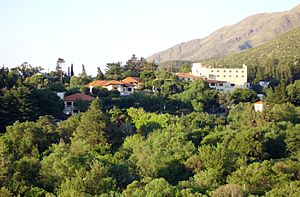
The Sierras de Córdoba are one of Argentina's most important holiday spots. About three million tourists visit the Sierras every year. The most popular places for tourists include Villa Carlos Paz, Cosquín, La Falda, Alta Gracia, and Villa General Belgrano.
Wineries: A Taste of the Sierras
In the past, two areas were big wine producers: Colonia Caroya in the north and Villa Dolores in the west. These areas traditionally made cheaper, sweet wines for people in Argentina to drink.
More recently, skilled winemaking has started to grow. This is happening in the traditional areas and in new, exciting places on the eastern side of the mountains. These new areas are around Villa General Belgrano and La Cumbrecita. This region has a cooler climate, with some light snowfall in winter. Several small, special wineries have tried different grape types and methods. Sometimes, they get amazing results. For example, Familia Navarro Torre recently won a gold medal for a Cabernet-Malbec wine from 2009. The region is also known for its craft beers. This is because of the large German Argentine community that lives there.
See also
 In Spanish: Sierras de Córdoba para niños
In Spanish: Sierras de Córdoba para niños
- Geological history of the Precordillera terrane


